HYUNDAI GENESIS G80 2008 Owners Manual
Manufacturer: HYUNDAI, Model Year: 2008, Model line: GENESIS G80, Model: HYUNDAI GENESIS G80 2008Pages: 332, PDF Size: 20.46 MB
Page 271 of 332
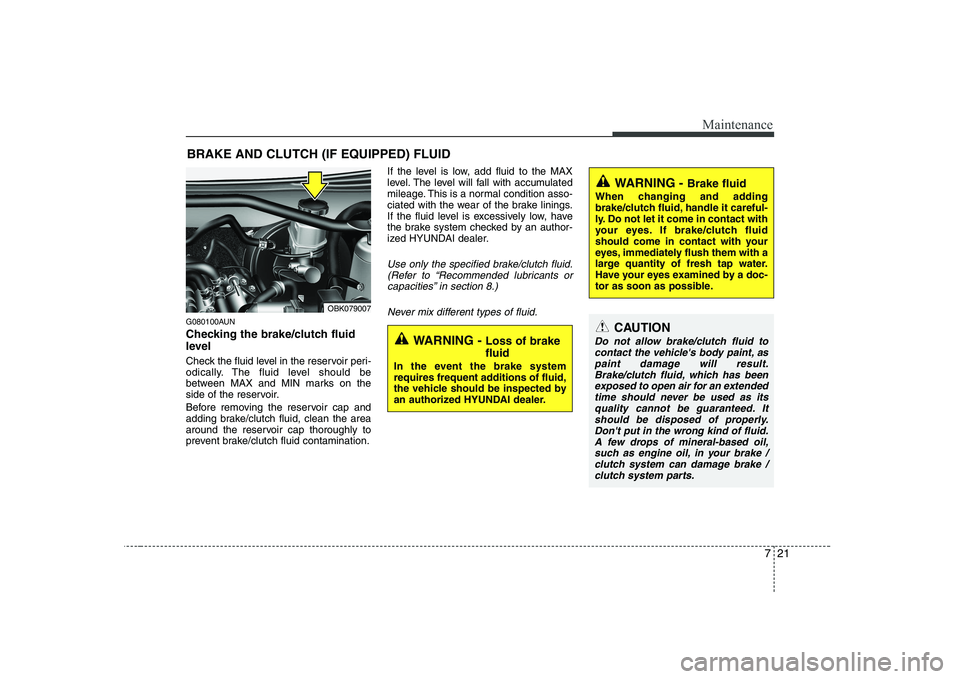
721
Maintenance
BRAKE AND CLUTCH (IF EQUIPPED) FLUID
G080100AUN
Checking the brake/clutch fluid
level
Check the fluid level in the reservoir peri-
odically. The fluid level should be
between MAX and MIN marks on the
side of the reservoir.
Before removing the reservoir cap and
adding brake/clutch fluid, clean the area
around the reservoir cap thoroughly to
prevent brake/clutch fluid contamination. If the level is low, add fluid to the MAX
level. The level will fall with accumulated
mileage. This is a normal condition asso-
ciated with the wear of the brake linings.
If the fluid level is excessively low, have
the brake system checked by an author-
ized HYUNDAI dealer.
Use only the specified brake/clutch fluid.
(Refer to “Recommended lubricants or capacities” in section 8.)
Never mix different types of fluid.
WARNING - Brake fluid
When changing and adding
brake/clutch fluid, handle it careful-
ly. Do not let it come in contact with
your eyes. If brake/clutch fluid
should come in contact with your
eyes, immediately flush them with a
large quantity of fresh tap water.
Have your eyes examined by a doc-
tor as soon as possible.
WARNING - Loss of brake fluid
In the event the brake system
requires frequent additions of fluid,
the vehicle should be inspected by
an authorized HYUNDAI dealer.
OBK079007
CAUTION
Do not allow brake/clutch fluid to contact the vehicle's body paint, as paint damage will result.
Brake/clutch fluid, which has been exposed to open air for an extendedtime should never be used as itsquality cannot be guaranteed. Itshould be disposed of properly.
Don't put in the wrong kind of fluid.A few drops of mineral-based oil, such as engine oil, in your brake /clutch system can damage brake /
clutch system parts.
Page 272 of 332
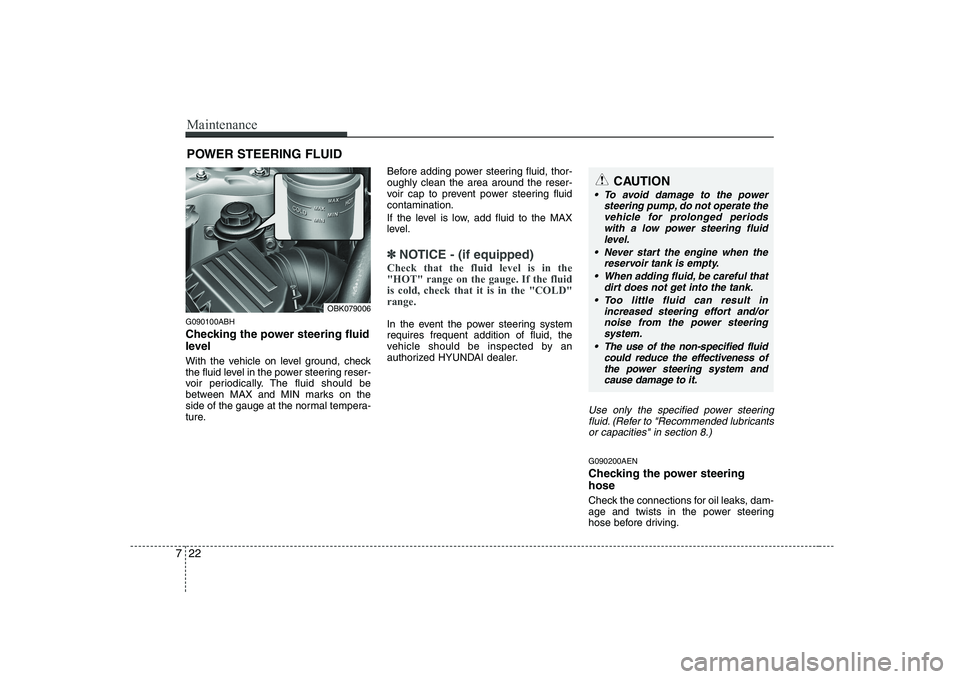
Maintenance
22
7
POWER STEERING FLUID
G090100ABH
Checking the power steering fluid
level
With the vehicle on level ground, check
the fluid level in the power steering reser-
voir periodically. The fluid should be
between MAX and MIN marks on the
side of the gauge at the normal tempera-
ture. Before adding power steering fluid, thor-oughly clean the area around the reser-
voir cap to prevent power steering fluidcontamination.
If the level is low, add fluid to the MAX
level.
✽✽
NOTICE - (if equipped)
Check that the fluid level is in the "HOT" range on the gauge. If the fluidis cold, check that it is in the "COLD"range.
In the event the power steering system requires frequent addition of fluid, the
vehicle should be inspected by an
authorized HYUNDAI dealer.
Use only the specified power steering fluid. (Refer to "Recommended lubricantsor capacities" in section 8.)
G090200AEN
Checking the power steering hose
Check the connections for oil leaks, dam-
age and twists in the power steering
hose before driving.
CAUTION
To avoid damage to the power
steering pump, do not operate thevehicle for prolonged periods with a low power steering fluid
level.
Never start the engine when the reservoir tank is empty.
When adding fluid, be careful that dirt does not get into the tank.
Too little fluid can result in increased steering effort and/or
noise from the power steeringsystem.
The use of the non-specified fluid could reduce the effectiveness of
the power steering system and cause damage to it.
OBK079006
Page 273 of 332
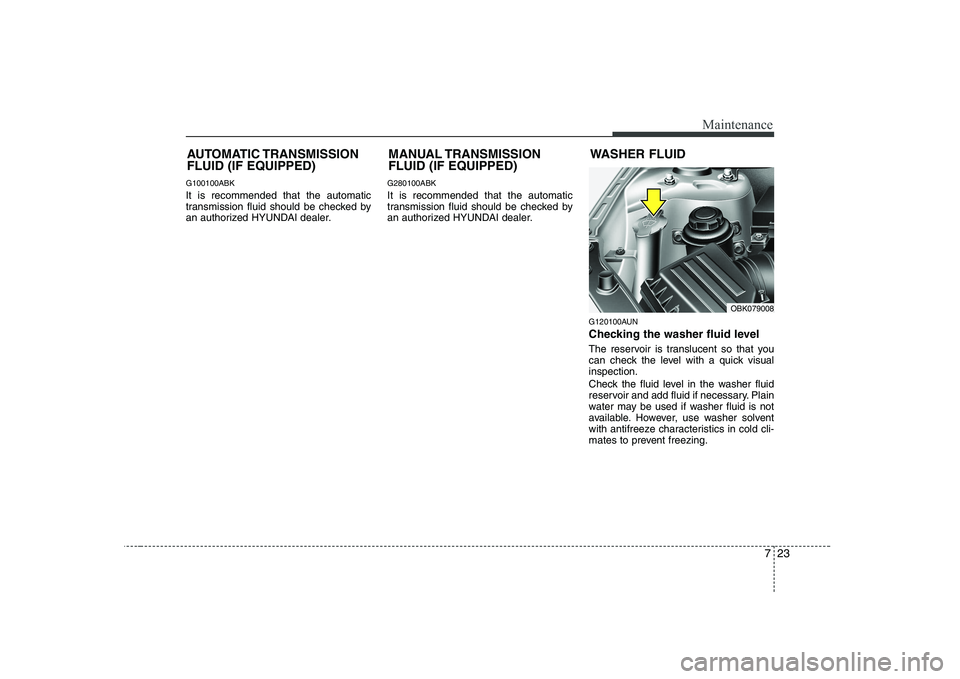
723
Maintenance
G100100ABK It is recommended that the automatic
transmission fluid should be checked by
an authorized HYUNDAI dealer.G280100ABK It is recommended that the automatic
transmission fluid should be checked by
an authorized HYUNDAI dealer.
G120100AUN
Checking the washer fluid level
The reservoir is translucent so that you
can check the level with a quick visualinspection.
Check the fluid level in the washer fluid
reservoir and add fluid if necessary. Plain
water may be used if washer fluid is not
available. However, use washer solvent
with antifreeze characteristics in cold cli-
mates to prevent freezing.
AUTOMATIC TRANSMISSION
FLUID (IF EQUIPPED) MANUAL TRANSMISSION
FLUID (IF EQUIPPED) WASHER FLUID
OBK079008
Page 274 of 332
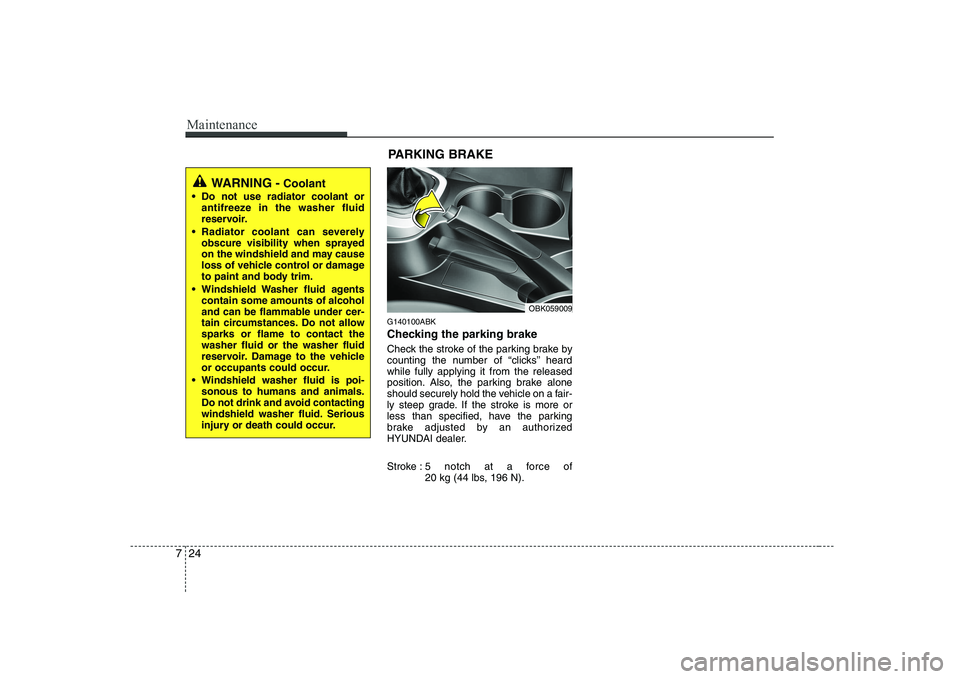
Maintenance
24
7
G140100ABK
Checking the parking brake
Check the stroke of the parking brake by
counting the number of “clicks’’ heardwhile fully applying it from the released
position. Also, the parking brake alone
should securely hold the vehicle on a fair-
ly steep grade. If the stroke is more or
less than specified, have the parking
brake adjusted by an authorized
HYUNDAI dealer.
Stroke : 5 notch at a force of
20 kg (44 lbs, 196 N).
WARNING - Coolant
Do not use radiator coolant or antifreeze in the washer fluid
reservoir.
Radiator coolant can severely obscure visibility when sprayed
on the windshield and may cause
loss of vehicle control or damage
to paint and body trim.
Windshield Washer fluid agents contain some amounts of alcohol
and can be flammable under cer-
tain circumstances. Do not allowsparks or flame to contact thewasher fluid or the washer fluid
reservoir. Damage to the vehicle
or occupants could occur.
Windshield washer fluid is poi- sonous to humans and animals.
Do not drink and avoid contacting
windshield washer fluid. Serious
injury or death could occur.
OBK059009
PARKING BRAKE
Page 275 of 332
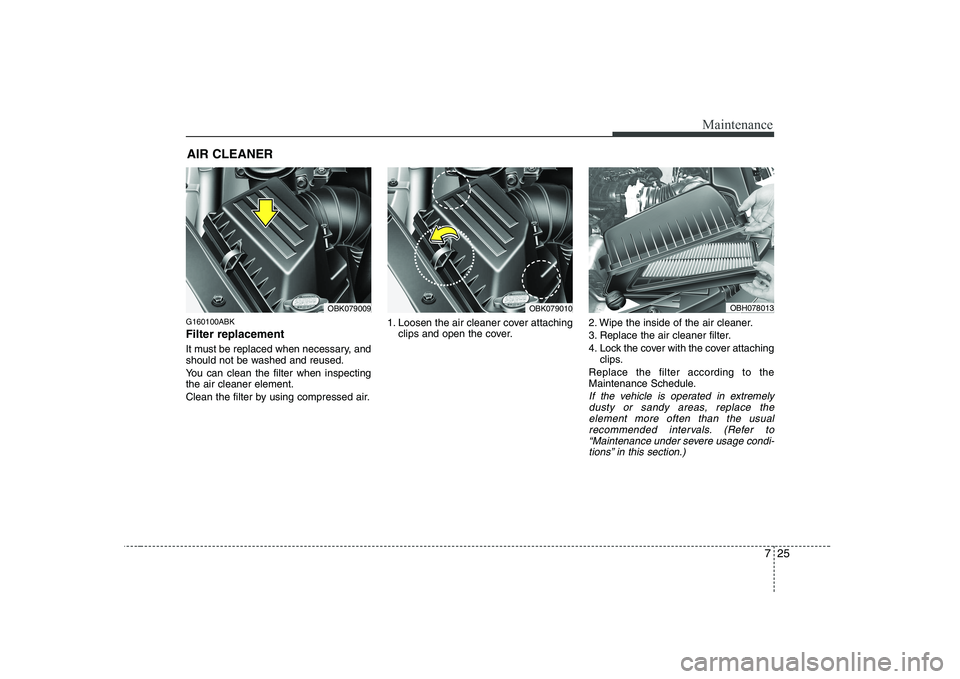
725
Maintenance
AIR CLEANER
G160100ABK Filter replacement
It must be replaced when necessary, and
should not be washed and reused.
You can clean the filter when inspecting the air cleaner element.
Clean the filter by using compressed air.1. Loosen the air cleaner cover attaching
clips and open the cover. 2. Wipe the inside of the air cleaner.
3. Replace the air cleaner filter.
4. Lock the cover with the cover attaching
clips.
Replace the filter according to the
Maintenance Schedule.
If the vehicle is operated in extremely dusty or sandy areas, replace the element more often than the usual recommended intervals. (Refer to “Maintenance under severe usage condi-
tions” in this section.)
OBK079009OBK079010OBH078013
Page 276 of 332
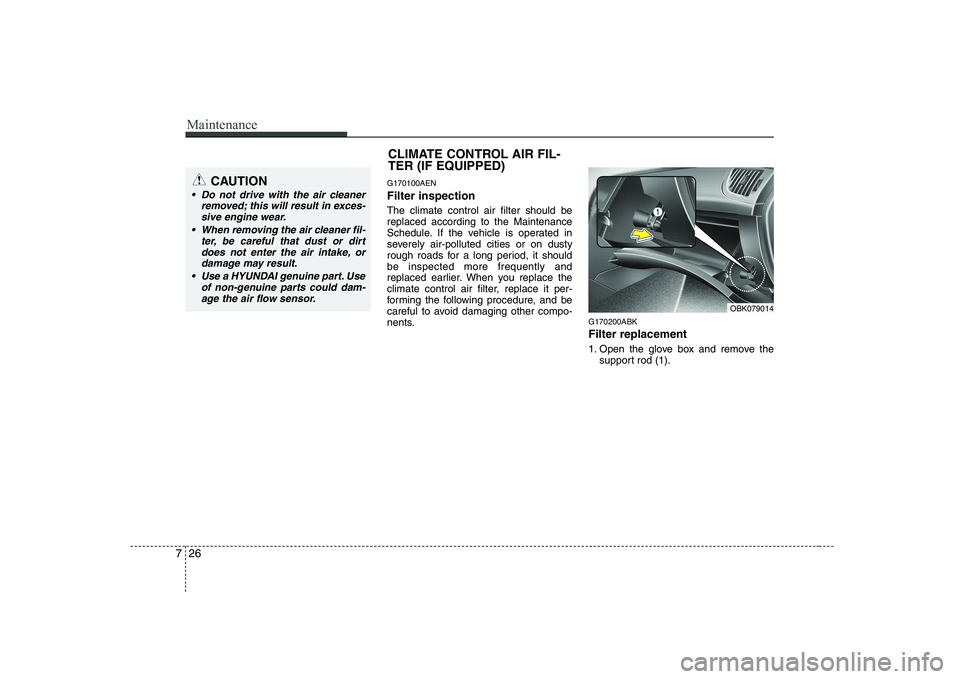
Maintenance
26
7
G170100AEN Filter inspection The climate control air filter should be replaced according to the Maintenance
Schedule. If the vehicle is operated in
severely air-polluted cities or on dusty
rough roads for a long period, it shouldbe inspected more frequently and
replaced earlier. When you replace the
climate control air filter, replace it per-
forming the following procedure, and be
careful to avoid damaging other compo-
nents. G170200ABK Filter replacement
1. Open the glove box and remove the
support rod (1).CAUTION
Do not drive with the air cleaner
removed; this will result in exces-sive engine wear.
When removing the air cleaner fil- ter, be careful that dust or dirt
does not enter the air intake, ordamage may result.
Use a HYUNDAI genuine part. Use of non-genuine parts could dam-age the air flow sensor.
CLIMATE CONTROL AIR FIL-
TER (IF EQUIPPED)
OBK079014
Page 277 of 332
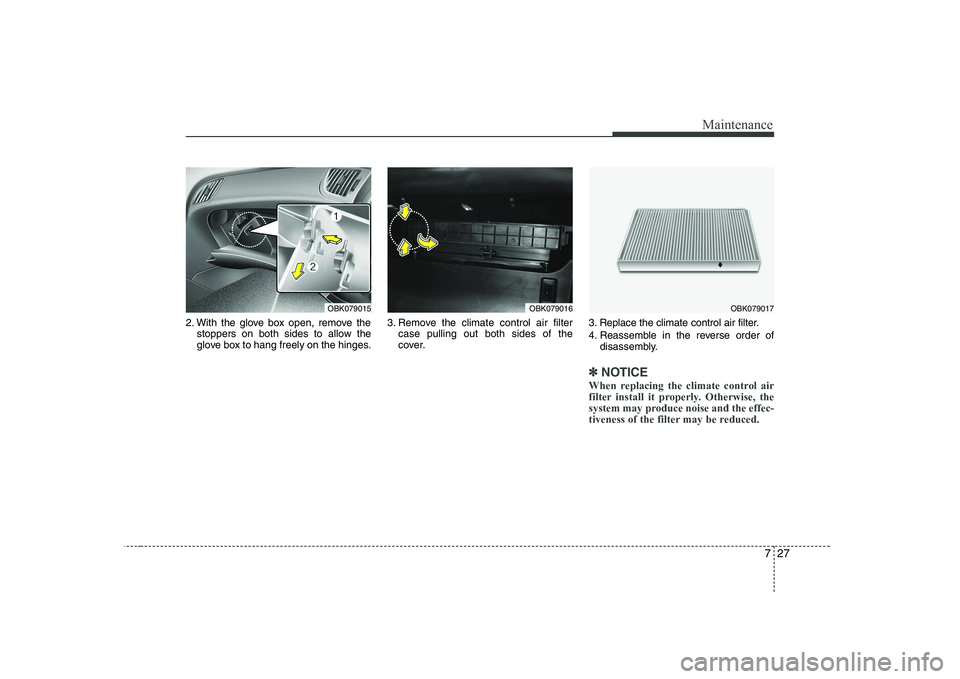
727
Maintenance
2. With the glove box open, remove thestoppers on both sides to allow the
glove box to hang freely on the hinges. 3. Remove the climate control air filter
case pulling out both sides of the
cover. 3. Replace the climate control air filter.
4. Reassemble in the reverse order of
disassembly.
✽✽ NOTICE
When replacing the climate control air
filter install it properly. Otherwise, the
system may produce noise and the effec-
tiveness of the filter may be reduced.
OBK079016OBK079017OBK079015
Page 278 of 332
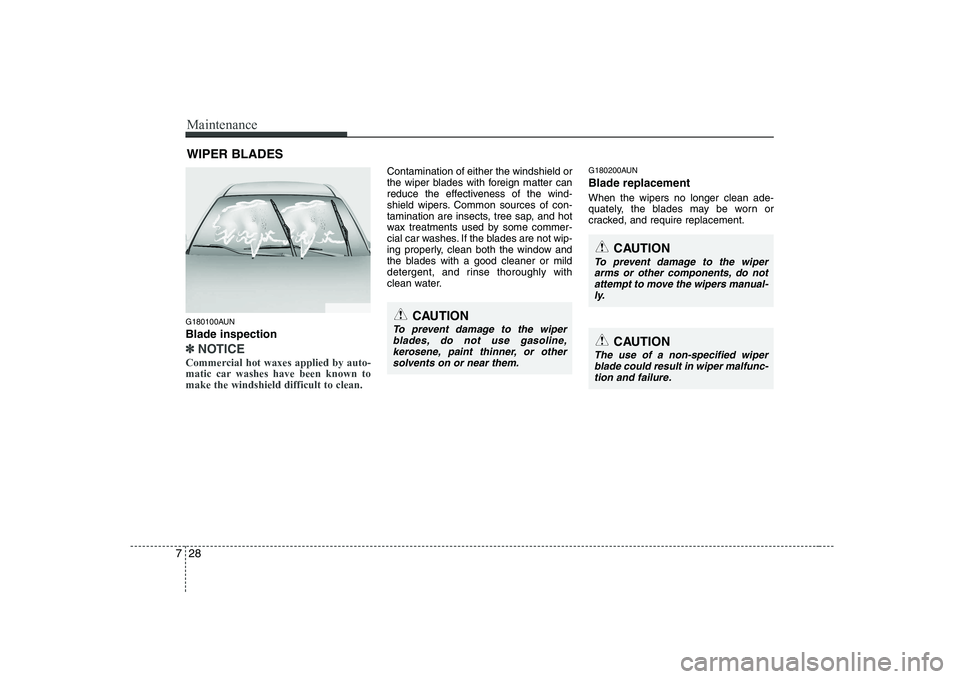
Maintenance
28
7
WIPER BLADES
G180100AUN Blade inspection
✽✽ NOTICE
Commercial hot waxes applied by auto-
matic car washes have been known tomake the windshield difficult to clean.
Contamination of either the windshield or
the wiper blades with foreign matter can
reduce the effectiveness of the wind-
shield wipers. Common sources of con-
tamination are insects, tree sap, and hot
wax treatments used by some commer-
cial car washes. If the blades are not wip-
ing properly, clean both the window and
the blades with a good cleaner or mild
detergent, and rinse thoroughly with
clean water. G180200AUN Blade replacement When the wipers no longer clean ade-
quately, the blades may be worn or
cracked, and require replacement.
CAUTION
To prevent damage to the wiper
blades, do not use gasoline,
kerosene, paint thinner, or other solvents on or near them.
CAUTION
To prevent damage to the wiper
arms or other components, do not attempt to move the wipers manual-ly.
CAUTION
The use of a non-specified wiper
blade could result in wiper malfunc- tion and failure.
Page 279 of 332
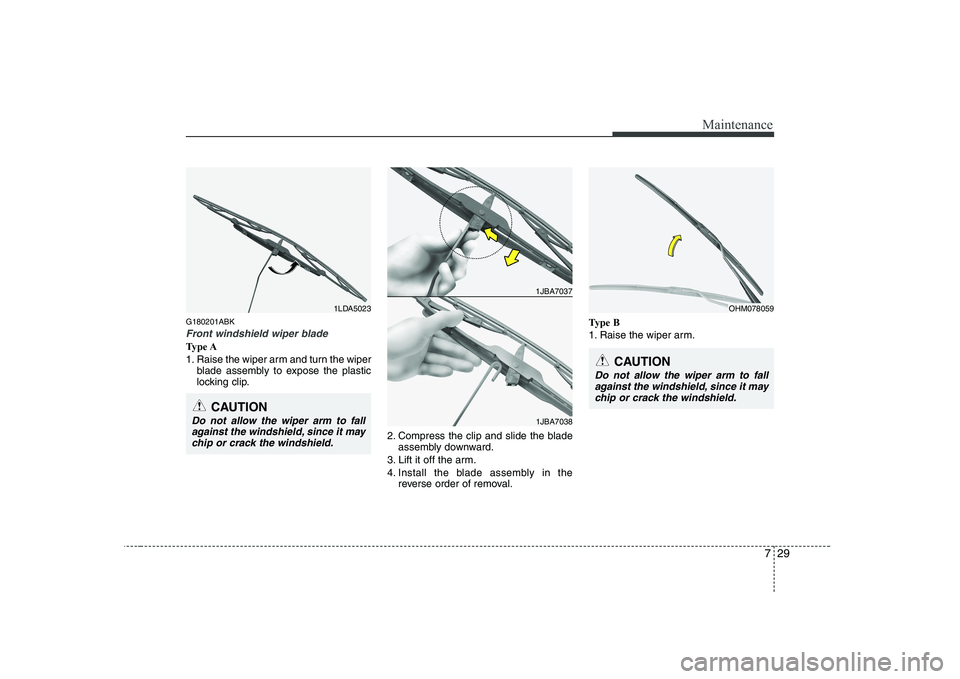
729
Maintenance
G180201ABK
Front windshield wiper blade
Type A
1. Raise the wiper arm and turn the wiperblade assembly to expose the plastic
locking clip.
2. Compress the clip and slide the bladeassembly downward.
3. Lift it off the arm.
4. Install the blade assembly in the reverse order of removal. Type B
1. Raise the wiper arm.
1LDA5023
CAUTION
Do not allow the wiper arm to fall
against the windshield, since it maychip or crack the windshield.
1JBA7037
1JBA7038
OHM078059
CAUTION
Do not allow the wiper arm to fallagainst the windshield, since it may chip or crack the windshield.
Page 280 of 332
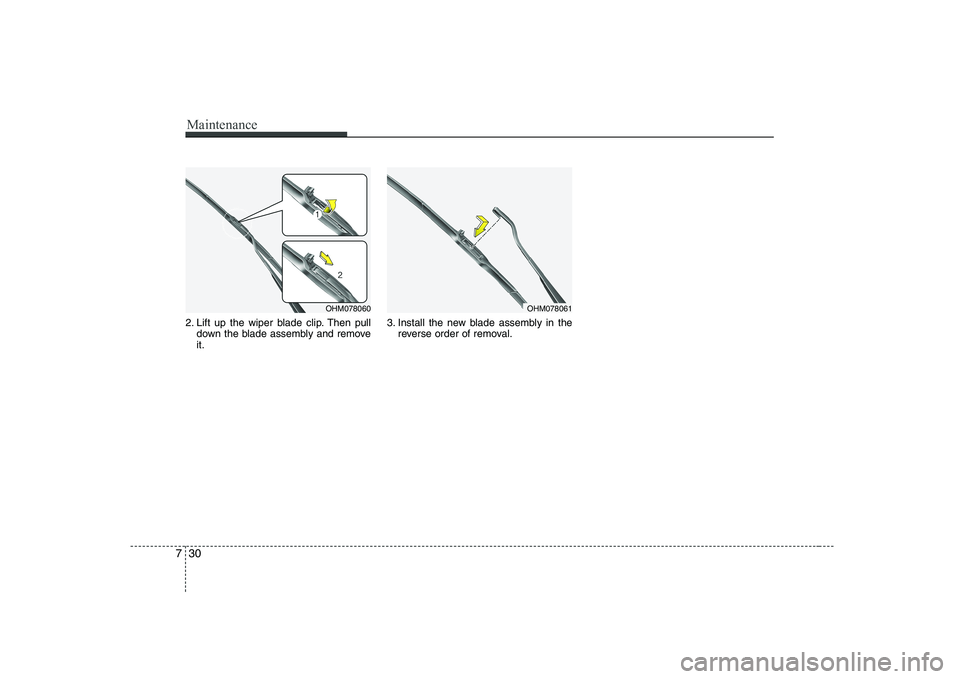
Maintenance
30
7
2. Lift up the wiper blade clip. Then pull
down the blade assembly and remove it. 3. Install the new blade assembly in the
reverse order of removal.
OHM078060OHM078061